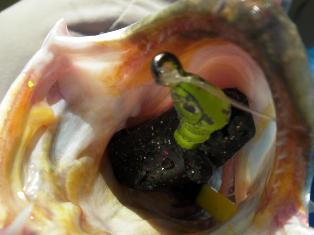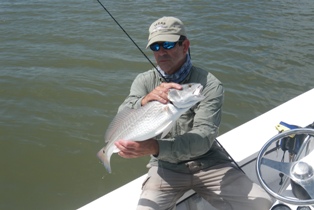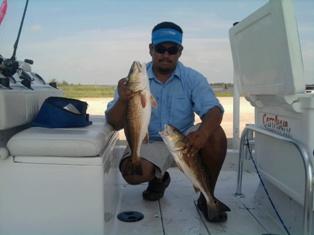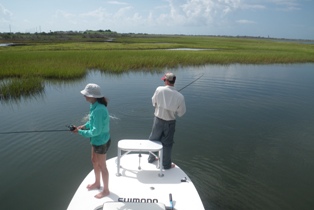Sight Fishers’ Guide
~Captain Steve Soule'~
Sight fishing can be one of the most exciting ways to fish. It can also be one of the most challenging and complex. There are a lot of things that must come together to make a good sight fishing experience. Every day is different, in the things that you will see, reaction of the fish and the conditions that you will have to deal with. I have collected a lot of memories over the years and have always tried to put myself in situations where I can sight cast. By now, it’s safe to say that I have thousands of hours practicing my sight casting skills and learning from the fish. My experience has come from all over the Gulf of Mexico coastal waters, from Texas to Florida, and there a many consistencies that I have learned. I have put together a short (ish) list of some of the things that will come in handy to anyone who finds shallow water and sight casting of interest.
The location– First and foremost, if you want to be successful at sight fishing, you need to start in an area that holds fish. Now, not only does it need to hold fish, but they must be visible somehow. There are the obvious signs, tails, and other surface disruptions such as wakes or fish eating at the surface. Then there are some subtle details that can lead you to fish, surface activity from prey or bait species. Jumping shrimp, finger mullet, glass minnows and shad, though not always a guarantee. There are also clear water scenarios where you can actually see the fish in the water. It may take some time to uncover the best areas for the bay that you fish, but start by thinking shallow. If you are fishing in water greater than a foot deep, you probably won’t see much. . I can’t tell you everywhere to look because that would take all the fun out of this for you.
Understand the fish’s movements– This is where time on the water pays big dividends. If you have spent enough hours on the water you will have a better understanding of what the fish do at different tide stages and heights. Here are a couple of thoughts that will get you started. As a general rule, on an incoming tide, fish will move deeper onto the flats or farther into the marsh. On falling tides, fish will stage at the outside edges of flats and marshes, waiting for the prey to escape the falling water. Often on an open flat, the fish will move out slightly deeper to a change line like the transition from grass to sand, or a slight drop off edge along a flat. Trout and redfish, like to ambush their prey. Having a slight change in water depth, or structure change is the perfect place for them to stage and wait for feeding opportunities. As an angler, you should always be looking to find what concentrates fish in the area that you are fishing. Every spot is different, some will be better on certain tides. Don’t forget that tide height plays a big role in the location of the fish as well. If you know the structure on the flat, you will have a better understanding of where the fish will be able to find a desirable water level and structure at varying tide levels. I have spoken about this in previous articles, but always keep in mind that fish move and we have to learn to move with them.
The approach– This is an art, and requires skill to perfect. Noise becomes a huge issue, along with the anglers ability to move stealthily. It doesn’t really matter how you get to the fish, just that you do it quietly. Wading is often effective, but I have seen it too many times that if someone can’t wade quietly, they never see the fish. You have got to take your time when stalking fish. There is an added bonus of safety in doing this as well. Quiet is the key. I have to remind people on my boat that noise travels significantly farther through water. Voices aren’t normally the issue, it’s the sound of a foot step, or the errant placement of a solid object on the deck of a boat.
When you have a nearly silent poling skiff like I’m fishing from, every sound becomes more pronounced. Another stealth issue is that when we are in stalking mode, movements from the deck of the boat have to be kept to a minimum. The next time you are in calm water, move from one side of your boat to the other and watch the wave that results. In ultra shallow water, this “pressure wave” is like a fire alarm going off in a library. Fish feel this!! Even if they don’t spook immediately, they have been warned that something large is lurking nearby. Fish sense vibration and it is more the vibration that alerts them to movement, so like when you wade, every movement must be slow and deliberate, and every effort made to prevent additional sound or vibration.
Your equipment– Whether you wade, drift, pole or kayak, there is one single piece of equipment that can’t be overlooked if you want to be successful at sight casting. You absolutely must have a good pair of polarizing sunglasses. This is an area where a lot of people make a mistake. This is not just sunglasses, but polarized. You have to realize that the quality of the glasses that you choose will make a huge difference in your experience. But you have to have polarized glasses to see the fish, and signs of fish. Here’s where most people make the mistake, certain color lenses are better at allowing visibility in certain situations. For sight casting, you need either an amber or yellow tint. Gray lenses, though great at easing eye strain and blocking more light, are not going to give you the contrast that is needed to pick out a fish in the water. The amber and yellow tints tend to enhance color and allow you to see the red over green or other color separation that will help you spot fish in the water.
Obviously, the fish that you are targeting will have some bearing on the tackle that you use, but for now let’s talk about trout and redfish that are commonly found along the Texas Coast. I have a distinct affinity to sight casting with a fly rod, but I realize that this isn’t for everyone, so I will focus more on standard tackle. With the fly rod, an 8 weight is the standard, 6 and 7 weight rods will work on many days, and on some days higher winds and longer casts may make a 9 weight the better tool. For the most part, if you only had one fly rod for sight casting Texas waters, it would be an 8. With a fly rod, you can get very specific with the size and replication of the prey animals, so I won’t go into the details, as that is another article in itself.
As for the conventional gear, my preference most days is a 6’6” to 6’9” casting rod. The rod needs to be fairly light in the tip section to cast well with some of the lighter lures that will be used in sight casting. Once you get into this kind of fishing, and develop some skill at stalking fish, you will realize that you make a lot of close quarters cast. The power requirements of the rods are more in the fish fighting area, and the fact that the fight is often close to the boat, where controlling the fish is critical. Even though I don’t fish them much, spinning rigs can be exceptional when sight casting. I grew up using them, but have somehow outgrown them. Look for a Light to medium light (3 power) spinning rig in the 7 to 7’6” range. This will give you all the tip action you need to throw and finesse light weight lures, just make sure that the rod has adequate backbone to fight the fish.
Line and rigging aren’t much different that what you would normally use to throw lures on the bay. My personal preferences are mono in the 8-12 pound range or braid in the 8 pound diameter and 30 pound test. In the last year or so, I have switched all of my reels over to braid. It is especially advantageous with the spinning gear, where it won’t twist up like monofilament. Though I don’t think that our fish really demand the use of fluorocarbon leader for visibility reasons, it never hurts. The two main reasons that I use this leader system are: 1 it is very abrasion resistant and 2 braid and mono of smaller diameter tend to hang up in split rings. Make sure that you are buying the fluorocarbon spools designed for use as leader not fishing line, there is a difference. I find that 20 to 30 pound test is sufficient for the most abrasive trout and redfish and their haunts. Tie the line to leader with a Uni-Knot. It is a quick knot that is easy to learn, and very secure. It can also be trimmed very close to prevent the “grass gathering” that some other knots allow.
Your abilities– This proves to be more of a challenge to anglers than most of us would give it credit. If you haven’t spent time casting at a target, now is the time. I have fished with a lot of very experienced anglers over the years, but most who haven’t spent time with this type of fishing, struggle at first. Most anglers, who go out and fish the bays, don’t really have to hit pinpoint accuracy with our casts. We tend to throw at a general area and spend more time focused on the distance aspect of the cast. I guess that having grown up sight casting, I learned early that throwing at a target often yields a better result. I rarely cast without having a target in mind. Practice this! When you are on the water fishing, pick targets, and learn to hit them consistently. When you get your sight casting shots, you will have to be spot on to get the most bites. Here are a few targets that will improve your open water fishing as well. Cast at every jumping mullet, shrimp or glass minnow that you see. Practice getting very close to the target, and understanding which direction they are moving so that you can present the lure in front of the fish.
Proximity of the fish– I know, big words….what do they mean… The distance that you are from the fish is critical. I always have that urge to cast just as soon as I spot a fish. Granted, there is nothing like hooking a fish at a long distance and taking pride in the skill involved, but more often than not, those casts are the ones that failed. It’s beneficial to spot the fish at a greater distance, but better to wait until you understand what the fish is doing. If you spot the fish, but can’t tell what direction she is facing, your chances are only 50%. If you are patient and ease closer to the fish, determine the direction she is facing, your chances improve dramatically. Add to that, you can now make a gently cast, so that your offering lands without near as much commotion. If you are fishing in inches of water, this is critical, just like the sounds on the boat or wading, this can and will spook your fish.
Angle of attack– This one gets people all the time, at all experience levels. Don’t let yourself get in a hurry. Just like the distance above, the direction that you present the lure from can make all the difference in the world. Here’s what you have to understand: No species of fish, including apex predators like sharks, will eat an animal that swims directly towards their face. It’s not natural for any prey animal to swim directly at their predator. When you sight cast, this is blindingly obvious, you will see the scene played out over and over again. If you could sit and watch fish as they feed naturally, you would see, they always attack from the side or from behind. There is a funny correlation, think about the examples below. All of your short strikes, when blind fishing, are from behind. We often get a bite but can’t catch up to the fish fast enough to get the hook up. You never get a hit that immediately goes 180 degrees opposite of the direction of retrieve.
We have all dealt with this, but until you watch a fish’s reaction to a lure swimming at them, you may not make the connection, and yes I have tried with sharks in clear water. To the extreme, I have watched sharks greater than 5 feet turn away from a lure that was only inches, swimming towards them at too small of an angle. Next cast placed correctly, instant hook up!
Think of it this way, your casts should be at angles as near to 90 degrees, or perpendicular to the fish as possible. Your presentation should cross the path of the fish, close enough to be noticed, but not so close that the fish spooks. Vague, I know, but it varies from day to day and fish to fish. This is something that you learn from time watching fish in the water. There are 3 typical scenarios that you will see in shallow water sight fishing. 1) Tailing fish 2) Cruising fish 3) Laid up fish. Each is different and requires a different cast and “lead” to increase the odds of hook up.
Tailing fish, especially on the Upper Texas Coast, require a fairly close cast, often within a foot. On a calm day, I would say cast two feet beyond the fish, in a line where your lure will come within a foot or less as it passes the fish. This way you are less likely to disturb the fish when the lure lands, yet still will be able to get her attention. Some days tailing fish are so engrossed in what they are doing that this won’t work, then you have to present the lure closer. Start with more than you think is necessary then decrease. At least you won’t spook the fish before you get a decent shot. Pods of tailing fish are different. The biggest rule here is, don’t cast to the middle of the pod, pick the fish from the outside, and do NOT cast across the school.
Cruising fish, are often more challenging. Though they are usually up and feeding, they are now a moving target, where the tailing fish was nearly stationary. Again keep the angle as near to 90 degrees as possible, and watch the fish so that you can get a feel for speed and direction. Lead should be in the range of 2 & 2. In other words, the cast should be two feet beyond the fish, and two feet in front of the fish. Some days, this distance will have to be increased, such as ultra clear and ultra shallow water. The same would apply on a very calm day. Other days, you may have to land the lure very close to get the fish’s attention due to water conditions or fish that are actively chasing prey and changing direction frequently.
Laid up fish. These are probably the most challenging fish to catch. Typically, this is how I spot big trout. They are often up on the flats for the solitude and protection afforded there. They are out of reach of most predators, and away from the majority of the boat traffic. (If you own a tunnel hull boat and read this thinking, I can find them on plane. Please don’t! You only reduce the odds of seeing them for all of us). Laid up fish aren’t moving and typically aren’t feeding. They are however opportunistic predators and can be convinced to eat. It takes exceptional stealth to get near them and a great presentation most days to get their attention. I say that they are the most difficult because they are so hard to see before you are on top of them. When you do spot the laid up fish, presentation is critical. Make sure that your angles are right. An overcast (cast beyond the fish) that will allow subtle lure presentation and a crossing path, yet not be too close or too far. I guess that the perfect cast would cross the fish at about 12 to 16 inches ahead. If you get too close, you risk spooking the fish, too far and they just won’t move or even notice your lure.
If you are starting to get exited, welcome to my world. I have been living with these visions of fish lurching forward to eat my lures and flies for nearly 3 decades now. There are truly few things in inshore fishing that are more exciting than stalking a big fish in shallow water and executing a perfect cast. Especially when your perfect cast gets eaten and you get to watch the whole scene played out in real time. Adding the visual aspect to the fishing knocks the excitement level through the roof. It takes a lot of preparation, skill and a good bit of luck to make it happen, but when you do, you won’t ever forget it. Watching that fish “hunted” fish perk up, pectoral fins straight out, the kick of the tail, and then the gill flare as she eats. Now all you have to do is make sure that you don’t react too soon. Learning the proper hook-set is the final ingredient to the experience. I preach this method in all situations, sight casting and fishing with top waters are where it is most evident, but it applies anywhere that you can see or feel a fish bite. It goes back to how “does the fish eat?”, from behind or beside its prey!
When you see a fish take a lure, DON’T REACT!!!! Continue your retrieve. You can’t set the hook effectively until the fish has closed her mouth, and your odds will improve dramatically after the fish has changed direction. Think about all those bites that you couldn’t ever catch up to. The fish is coming towards you and it is just too easy to pull the lure right back out of the hole that it went into. When you see or feel the bite, continue the retrieve or reel down until the line comes tight to the fish. Usually, this will be enough to get the fish to change direction, and in most cases, if the line is already tight, you won’t have to set the hook much. If you feel the need, use a low to the water sweeping motion, not an upward swing. If you do pull the lure away from the fish, it won’t go as far as with an upward motion.
Now that you understand how and where to look, the subtleties of the approach and presentation, there’s only one thing left. Pick a day and get on the water for some new and challenging fishing fun!
Good luck and tight lines!




























 By Laura Elder
By Laura Elder